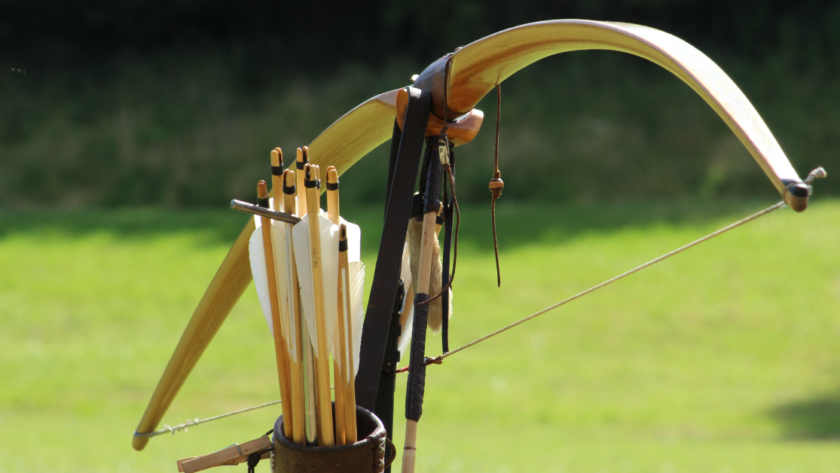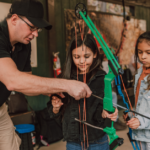I’ll never forget the day I first picked up a bow. The smooth curve of the riser, the tension in the string, and the satisfying thwack of the arrow hitting the target – it was love at first shot.
But like many beginners, I quickly realized that having the right equipment can make or break your archery experience.
When I started out, I was overwhelmed by the sheer variety of gear available. Should I go for a recurve or compound bow?
What draw weight is suitable?
Do I really need all those fancy accessories? These questions swirled in my mind as I stood in the archery shop, feeling like a fish out of water.
Over time, I’ve learned that while archery can be as simple or as complex as you want it to be, there are some essential pieces of kit that every beginner should have. Let’s break down the bare basics and then explore some helpful add-ons that can enhance your archery skills.
The Bare Essentials
Choosing Your First Bow
The cornerstone of your archery kit is, of course, the bow itself. For beginners, I always recommend starting with a recurve bow.
They’re simpler in design, more forgiving to shoot, and generally less expensive than their compound counterparts.
When selecting your first recurve bow, pay close attention to the draw weight. As a rule of thumb, adult beginners should look for bows with a draw weight between 15-25 pounds.
This range offers enough power to shoot effectively while still being manageable for developing proper form.
Remember, the right bow should feel comfortable when you draw it. Don’t be tempted to go for a higher draw weight thinking it’ll make you a better archer – that’s a recipe for poor form and potential injury.
Start low and work your way up as your strength and technique improve.
Recurve Bow Components
- Riser: The central part of the bow that you hold.
It’s typically made of metal or wood and connects the limbs.
- Limbs: The upper and lower parts of the bow that flex when you draw the string.
They store the energy that propels the arrow.
- String: The part you pull back to shoot.
It’s usually made of synthetic materials for durability and consistency.
- Nocking Point: A small bead or metal crimp on the string that marks where you should nock (attach) your arrow.
- Arrow Rest: A small shelf or device on the riser where the arrow sits before and during the shot.
Arrows: Your Bow’s Best Friend
Choosing the right arrows is just as crucial as selecting the right bow. Your arrows need to match both your bow’s draw weight and your personal draw length.
For beginners, I suggest starting with aluminum arrows. They’re durable, reasonably priced, and offer consistent performance.
When it comes to arrow spine (stiffness), err on the side of slightly stiffer arrows if you’re unsure.
A too-flexible arrow can be dangerous, while a slightly stiffer one will still fly true enough for a beginner.
As you progress, you can fine-tune your arrow selection for optimal performance. Here are some key factors to consider when choosing arrows:
- Length: Your arrows should be slightly longer than your draw length. A good rule of thumb is to add 1-2 inches to your draw length.
- Spine: This refers to the arrow’s stiffness. The fix spine depends on your draw weight and arrow length.
- Weight: Heavier arrows are more stable but slower, while lighter arrows are faster but more affected by wind.
- Fletching: The feathers or vanes at the back of the arrow. They help stabilize the arrow in flight.
- Nock: The plastic insert at the back of the arrow that clips onto the bowstring.
Protecting Yourself: Arm Guard and Finger Tab
Trust me on this one – you don’t want to experience string slap without an arm guard. This simple piece of equipment protects your forearm from the sting of the bowstring, allowing you to focus on your form without fear of pain. Look for an adjustable arm guard that covers your entire forearm for maximum protection.
Equally important is a finger tab or glove to protect your drawing fingers from the friction of the string. Personally, I prefer a finger tab as it offers better sensitivity, but some archers swear by gloves.
Try both and see what feels most comfortable for you.
Choosing the Right Arm Guard
- Coverage: Make sure it covers from your wrist to just below your elbow.
- Material: Look for durable materials like leather or synthetic fabrics.
- Adjustability: Straps or elastic bands confirm a snug fit.
- Comfort: It should be comfortable enough to wear for extended periods.
Finger Tab vs. Glove
Finger Tab:
- Offers better string feel
- Typically less expensive
- Easy to replace
- Can be customized for fit
Glove:
- Provides full finger protection
- Some archers find them more comfortable
- Can be used in colder weather
- May last longer than tabs
Your First Target: Where Arrows Meet Their Mark
While it might be tempting to set up some cardboard boxes in your backyard, investing in a proper target will significantly improve your practice sessions. For beginners, I recommend a foam target.
They’re affordable, easy to set up, and stop arrows effectively without causing damage.
As you progress, you might want to consider a bag target for it’s durability and ease of arrow removal. Here are some target options to consider:
- Foam Block Targets:
- Lightweight and portable
- Great for indoor and outdoor use
- Easy arrow removal
- May wear out faster with frequent use
- Bag Targets:
- Durable and long-lasting
- Excellent for high-volume shooting
- Easy arrow removal
- Can be heavy and less portable
- 3D Targets:
- Realistic animal shapes for hunting practice
- Helps improve aim at vital areas
- More expensive than other options
- May need more frequent replacement
- Paper Targets:
- Inexpensive and disposable
- Great for tracking accuracy
- Requires a backing (like a foam target)
- Not suitable for outdoor use in wet conditions
Keeping Your Arrows Close: The Quiver
A quiver is essential for safely and conveniently carrying your arrows. For beginners, a hip quiver is usually the best choice.
It keeps your arrows within easy reach and doesn’t interfere with your shooting form.
Plus, it makes you feel like a real archer from the get-go!
Types of Quivers
- Hip Quiver:
- Attaches to your belt
- Easy access to arrows
- Doesn’t interfere with shooting form
- Great for target archery
- Back Quiver:
- Worn on the back
- Traditional look
- Can hold more arrows
- May be less convenient for quick access
- Bow Quiver:
- Attaches directly to the bow
- Keeps arrows close to the bow
- Can affect bow balance
- Popular for hunting
- Ground Quiver:
- Stands on the ground
- Ideal for stationary target practice
- Not portable during shooting
Helpful Add-ons
Once you’ve got the basics down, there are several accessories that can enhance your archery experience and help improve your accuracy.
Bow Sight: Aiming with Precision
A bow sight can dramatically improve your accuracy by providing a clear reference point for aiming. Adjustable sights allow you to fine-tune your aim for different distances, making them invaluable as you progress in the sport.
However, I always advise beginners to spend some time shooting without a sight first. This helps develop a feel for the bow and a more intuitive understanding of aiming.
Types of Bow Sights
- Fixed Pin Sights:
- Multiple pins set for different distances
- Simple and reliable
- Great for hunting and 3D archery
- Movable Pin Sights:
- Single pin that can be adjusted for different distances
- Offers precise aiming
- Requires more time to adjust in the field
- Pendulum Sights:
- Automatically adjusts for different shooting angles
- Ideal for tree stand hunting
- Less versatile for target archery
- Target Sights:
- Highly adjustable for precise aiming
- Often used in competitive target archery
- More complex and expensive
Arrow Rest: Consistency is Key
An arrow rest provides a consistent platform for your arrow, improving both accuracy and arrow flight. There are various types available, from simple stick-on rests to more advanced drop-away rests.
For beginners, a basic stick-on rest is usually enough and easy to install.
Popular Arrow Rest Types
- Stick-On Rests:
- Simple and inexpensive
- Easy to install
- Good for beginners
- May wear out quickly with heavy use
- Flipper Rests:
- More durable than stick-on rests
- Provides good arrow clearance
- Suitable for target archery and hunting
- Whisker Biscuit:
- Fully encircles the arrow
- Great for hunting, as it keeps the arrow secure
- May slightly reduce arrow speed
- Drop-Away Rests:
- Drops out of the way as the arrow is released
- Provides excellent arrow clearance
- More complex to set up and maintain
Stabilizer: Steady as She Goes
A stabilizer might look like a simple rod attached to your bow, but it’s impact on your shooting can be significant. It helps reduce bow vibration and improves overall stability, leading to more consistent shots.
Start with a short, lightweight stabilizer and experiment with different lengths and weights as you progress.
How Stabilizers Work
- Vibration Reduction: The weight at the end of the stabilizer absorbs vibrations, reducing hand shock and noise.
- Improved Balance: By adding weight to the front of the bow, stabilizers help counteract the weight of other accessories.
- Increased Stability: The added weight makes it easier to hold the bow steady during aiming and release.
- Enhanced Follow-Through: A stabilizer can help maintain bow position after the shot, improving overall consistency.
Choosing a Stabilizer
- Length: Longer stabilizers (24-30 inches) offer more stability but can be cumbersome. Start with a shorter one (8-12 inches) and increase as needed.
- Weight: Heavier stabilizers provide more stability but can tire you out faster. Begin with a lighter weight and adjust as your strength improves.
- Material: Carbon fiber stabilizers are lightweight and absorb vibration well, while aluminum ones are more affordable.
- Adjustability: Some stabilizers allow you to add or remove weights, providing flexibility as you refine your setup.
Bow Stringer: Safety First
If you’re using a recurve bow, a bow stringer is an essential tool for safely stringing and unstringing your bow. It protects your bow limbs from potential damage and makes the process much easier.
Trust me, trying to string a bow without one is a recipe for frustration (and possibly injury).
How to Use a Bow Stringer
- Place the larger loop of the stringer over the upper limb of the bow.
- Slide the smaller loop over the lower limb.
- Step on the center of the stringer with both feet, shoulder-width apart.
- Grasp the bow handle with both hands and pull up, bending the limbs.
- Slide the bowstring into place on the upper limb.
- Slowly lower the bow, ensuring the string is seated properly in both limb grooves.
- Remove the stringer and check that the string is secure.
Bow Case: Protect Your Investment
A good bow case is crucial for protecting your equipment during storage and transport. Soft cases are great for convenience, while hard cases offer maximum protection.
If you plan on traveling with your bow or storing it for extended periods, a hard case is worth the investment.
Types of Bow Cases
- Soft Cases:
- Lightweight and easy to carry
- Often less expensive
- Provide basic protection against dust and scratches
- Suitable for local transport and storage
- Hard Cases:
- Offer maximum protection against impacts and environmental factors
- Ideal for air travel or long-distance transport
- Often include foam inserts for custom fit
- More expensive but provide peace of mind
- Hybrid Cases:
- Combine elements of soft and hard cases
- Offer a balance of protection and portability
- Often feature semi-rigid construction
- Bow Socks:
- Simple fabric covers for basic protection
- Lightweight and compact
- Suitable for short-term storage or local transport
When choosing a case, consider factors like:
- The type of bow you have (recurve or compound)
- How you’ll be transporting your bow (car, plane, etc.)
- Storage space available at home
- Additional gear you need to carry (arrows, accessories)
Common Pitfalls and How to Avoid Them
As you set off on your archery journey, there are a few common mistakes to watch out for:
Overbowing: The Power Trap
Don’t start with a bow that’s too powerful for you. It’s better to master proper form with a lighter bow than to struggle with one that’s too heavy.
Signs you might be overbowing include:
- Shaking or struggling to hold the bow at full draw
- Inability to maintain proper form throughout the shot
- Rapid fatigue during practice sessions
- Difficulty achieving consistent accuracy
To avoid this, start with a lower draw weight and gradually increase as your strength and technique improve. Remember, archery is about precision, not raw power.
Neglecting Maintenance: The Silent Killer
Regular maintenance of your equipment is crucial. Wax your bowstring, check your arrows for damage, and keep your bow clean and dry.
Here’s a basic maintenance routine:
- Bowstring: Apply wax every 100-200 shots or when the string looks dry.
- Arrows: Inspect for cracks, loose fletching, or bent shafts before each shooting session.
- Bow: Wipe down with a dry cloth after use, especially if shooting in damp conditions.
- Limbs: Check for any signs of delamination or cracks.
- Accessories: Ensure all screws and attachments are tight before shooting.
For an in-depth look at how to maintain your bow and arrows, check out this article.
Inconsistent Anchor Point: The Accuracy Assassin
Develop a consistent anchor point (where your drawing hand touches your face) for improved accuracy. Common anchor points include:
- Corner of the mouth
- Under the chin
- Side of the jaw
Experiment to find what works best for you, then practice until it becomes second nature. A consistent anchor point is crucial for repeatable shots and improved accuracy.
Ignoring Safety: The Cardinal Sin
Always be aware of your surroundings and never shoot without a proper backstop. Basic safety rules include:
- Never dry fire your bow (release the string without an arrow)
- Always use a proper target backstop
- Be aware of what’s beyond your target
- Never point your bow at anything you don’t intend to shoot
- Inspect your equipment before each use
For more on safety tips for first-time shooters, check out this article.
Rushing the Process: The Patience Paradox
Archery is a skill that takes time to develop. Be patient with yourself and focus on consistent practice as opposed to immediate results.
Set realistic goals and celebrate small improvements.
Remember, even the best archers in the world started as beginners.
Adapting Your Kit as You Progress
As you grow more comfortable with the basics, you might want to explore different aspects of archery. Here are some ways to adapt your kit:
Target Archery: Precision and Consistency
For those drawn to the challenge of hitting bullseyes, target archery offers a structured and competitive environment. To excel in target archery, consider:
- Upgrading to carbon arrows: They offer better consistency and are less affected by wind.
- Investing in a high-quality target: Look for targets designed specifically for frequent use and easy arrow removal.
- Adding a long stabilizer: This can significantly improve your stability and accuracy at longer distances.
- Using a more precise sight: Consider a multi-pin or adjustable sight for different distances.
- Trying out a clicker: This device helps confirm consistent draw length, crucial for accuracy in target archery.
3D Archery: The Thrill of the Hunt
For those who enjoy a more dynamic shooting experience or are interested in bowhunting, 3D archery provides a great transition. To get started in 3D archery:
- Invest in 3D targets: These lifelike animal targets help you practice shot placement on realistic shapes.
- Consider broadhead-tipped arrows: These simulate hunting arrows and fly differently from field points.
- Use a rangefinder: This helps you judge distances accurately in varying terrain.
- Try a shorter stabilizer: This makes maneuvering in wooded areas easier.
- Experiment with different arrow weights: Heavier arrows can be useful for 3D courses with longer shots.
Traditional Archery: Back to Basics
If you’re drawn to the simplicity and challenge of traditional archery, consider a barebow setup. This involves removing sights and stabilizers for a more instinctive shooting style.
To transition to traditional archery:
- Remove your sight and stabilizer: This forces you to rely on instinctive aiming.
- Try wooden arrows: They complement the traditional feel and can be more forgiving.
- Experiment with different anchor points: Traditional archers often use a higher anchor point for better sight down the arrow.
- Consider a leather tab or glove: These offer a more traditional feel than modern materials.
- Practice at varying distances: This helps develop your instinctive distance judgment.
Compound Bows: Embracing Technology
If you’re interested in trying a compound bow, many archery shops offer rentals or trial sessions. Compound bows offer:
- Increased accuracy: The let-off at full draw allows for steadier aiming.
- More power: Compound bows can achieve higher arrow speeds with less effort.
- Adjustability: Many compound bows offer a wide range of draw weight and length adjustments.
- Consistency: The mechanical nature of compound bows can lead to more consistent shots.
- Versatility: They’re popular for both target archery and hunting.
Remember, the best kit is the one that suits your personal goals and shooting style. Don’t be afraid to experiment and find what works best for you.
Exercises to Improve Your Archery Skills
Developing your archery skills goes beyond just shooting at targets. Here are some exercises that can help improve various aspects of your archery:
Blank Bale Shooting: Form Focus
Practice your form by shooting at a large target from a close distance, focusing on your technique as opposed to aiming. This exercise helps:
- Develop muscle memory for proper form
- Improve release technique
- Increase awareness of body position and movement
To practice blank bale shooting:
- Set up a large target at close range (5-10 yards)
- Focus on one aspect of your form per session (e.g., anchor point, release, follow-through)
- Shoot without aiming, concentrating solely on the chosen aspect of your form
- Repeat for 20-30 arrows
Draw and Hold: Building Strength and Stability
Build strength and stability by drawing your bow and holding at full draw for increasing periods of time. This exercise:
- Improves muscle endurance
- Enhances stability at full draw
- Helps identify weaknesses in form
To practice draw and hold:
- Draw your bow to full draw
- Hold for 10-30 seconds (start with shorter times and increase gradually)
- Let down slowly without releasing
- Rest for 30 seconds
- Repeat 5-10 times
Blind Bale Shooting: Developing Feel
Close your eyes and focus on the feel of your shot, developing muscle memory and consistency. This exercise helps:
- Improve body awareness
- Enhance consistency in form
- Develop a better “feel” for your shot
To practice blind bale shooting:
- Set up a target at close range
- Draw your bow and aim as normal
- Close your eyes before releasing
- Focus on the feel of the shot process
- Open your eyes after follow-through to check results
Single Arrow Drill: Precision Focus
Shoot one arrow at a time, treating each shot as if it were your only one. This helps develop focus and precision.
The single arrow drill:
- Improves shot focus and concentration
- Enhances the quality of each shot
- Simulates high-pressure shooting situations
To practice the single arrow drill:
- Set up your target at your normal shooting distance
- Shoot a single arrow with full focus and proper form
- Retrieve the arrow
- Rest for 1-2 minutes
- Repeat for 10-20 shots
Distance Variation: Adaptability Training
Practice shooting at various distances to improve your distance judgment and adaptability. This exercise:
- Enhances distance estimation skills
- Improves adaptability to different shooting scenarios
- Helps develop a more intuitive understanding of arrow trajectory
To practice distance variation:
- Set up targets at various distances (e.g., 10, 20, 30 yards)
- Shoot a set number of arrows at each distance
- Vary the order in which you shoot the distances
- Focus on adjusting your aim and form for each distance
Key Takeaways
- Start with the essentials: a recurve bow, matched arrows, arm guard, finger tab, and target.
- Choose a bow with an suitable draw weight for your strength and skill level.
- Invest in protective gear to confirm a safe and enjoyable archery experience.
- Add accessories like sights and stabilizers as you become more comfortable with the basics.
- Regular practice and proper form are more important than having the most expensive equipment.
- Be patient with your progress and focus on consistent improvement as opposed to immediate results.
- Explore different aspects of archery as you develop your skills to find what you enjoy most.
- Use specific exercises to target different aspects of your archery skills.
- Always prioritize safety in your archery practice.
- Remember that archery is a blueprint that leads towards continuous learning and improvement.
Frequently Asked Questions
What is the best bow for a beginner archer?
For most beginners, a recurve bow with a draw weight between 15-25 pounds is ideal. It’s simple to use, affordable, and allows you to focus on developing proper form and technique.
How much does it cost to get started in archery?
The initial cost for basic archery equipment can range from $150 to $500, depending on the quality of gear you choose. This typically includes a bow, arrows, arm guard, finger tab, and a basic target.
Is archery a dangerous sport?
When proper safety protocols are followed, archery is one of the safest sports. Always use suitable safety gear, shoot in a controlled environment, and follow basic safety rules to minimize risks.
How often should I practice archery?
For beginners, practicing 2-3 times a week for about 30 minutes to an hour per session is a good start. Consistency is more important than long practice sessions.
Can I learn archery on my own?
While it’s possible to learn the basics on your own, taking lessons from a qualified instructor can help you develop proper form and avoid bad habits from the start.
What’s the difference between recurve and compound bows?
Recurve bows are simpler in design and rely more on the archer’s strength, while compound bows use a system of pulleys to provide mechanical advantage, making them easier to hold at full draw.
How do I decide my draw length?
A common method is to measure your arm span (fingertip to fingertip) and divide by 2.5. However, it’s best to have this measured by a professional at an archery shop for accuracy.
Are expensive bows worth it for beginners?
For beginners, mid-range equipment is usually sufficient. Expensive bows offer advanced features that beginners may not fully use or appreciate.
Focus on developing skills before investing in high-end equipment.
How long does it take to become proficient in archery?
The time it takes to become proficient varies greatly depending on natural ability, practice frequency, and quality of instruction. With regular practice, most people can see significant improvement within 3-6 months.
Can archery help improve mental focus?
Yes, archery can significantly improve mental focus and concentration. The sport needs a high level of mental discipline, which can translate to other areas of life.



